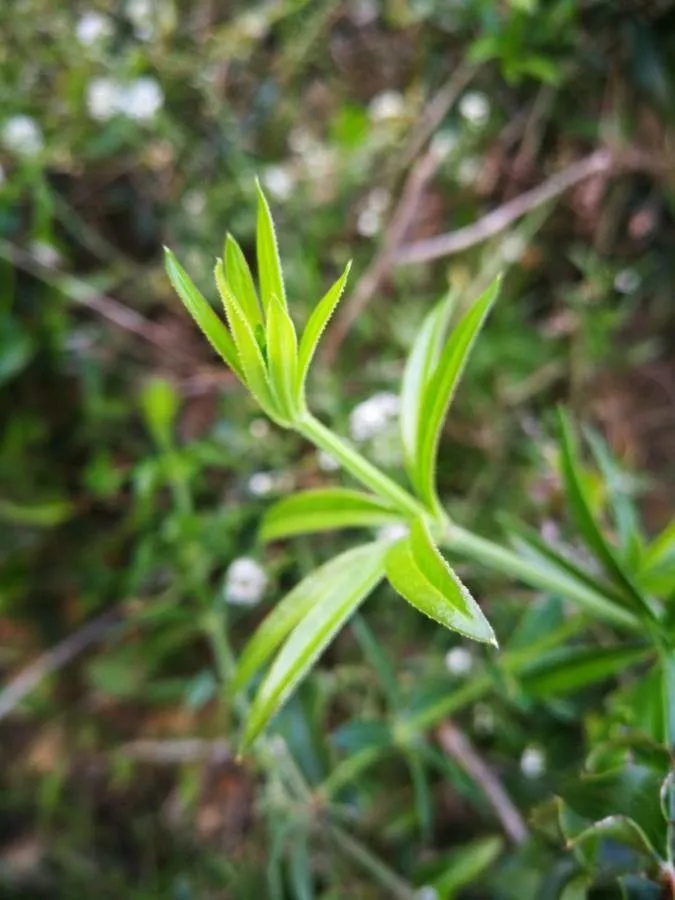
Author: L.
Bibliography: Sp. Pl.: 108 (1753)
Year: 1753
Status: accepted
Rank: species
Genus: Galium
Vegetable: Unknown
Observations: Subarctic & Temp. Northern Hemisphere
Northern bedstraw, known scientifically as Galium boreale, is a perennial herbaceous plant from the Rubiaceae family. This resilient species is predominantly found in the subarctic and temperate regions of the Northern Hemisphere, thriving in a variety of habitats including meadows, woodlands, and along riverbanks.
Distinguished by its delicate whorls of leaves, Northern bedstraw typically features small, slender stems that are erect and quadrangular. These stems are often adorned with clusters of tiny, star-shaped white flowers that emit a subtle yet pleasing fragrance, especially noticeable during their peak blooming periods in late spring to early summer.
The plant’s foliage is arranged in whorls of four, giving it a visually appealing symmetry. These narrow, lanceolate leaves are deep green in color, with a smooth texture that contrasts beautifully with the fluffy appearance of the flowers.
First classified by Carl Linnaeus in his seminal publication “Species Plantarum” in 1753, Galium boreale has since been a subject of interest for botanists and plant enthusiasts alike, thanks to its widespread habitat and the simplicity of its aesthetic charm. Its ability to adapt across various regions and conditions exemplifies the robustness of many members of the Rubiaceae family.
In addition to its ornamental appeal, Northern bedstraw also holds traditional importance in certain indigenous cultures, where it has been used for various purposes, including as a stuffing material for mattresses and pillows, attributing to its common name. The plant’s roots possess mild medicinal properties and have historically been employed in herbal remedies.
The unassuming beauty and ecological versatility of Northern bedstraw make it a fascinating plant to study and admire, showcasing the intricate balance of form and function in the natural world.
Deu: nordisches labkraut
Eng: northern bedstraw, boreal bedstraw, crosswort
Dan: trenervet snerre
Fin: ahomatara
Swe: ahomatara, vitmåra
Nor: fægre, hvit-mour, mour, taagmilde
Fra: gaillet boréal
Nob: hvitmaure
Nno: kvitmaure
Nld: noords walstro
Sme: vilgesmádir, gieddemáđir, gielda, máđir
Cym: briwydd, briwydd mynyddog-creigiog, briwydd tair gwythien, briwydd y gogledd, briwydden fynyddig, croesoglys wen, gwendon
En: Northern bedstraw, Northern bedstrw; fragrant bedstraw, Boreal bedstraw, Crosswort
Az: Şimal qatıqotu
Be: Маруна паўночная
Bg: Северно еньовче
Zh: 北方拉拉藤
Cs: Svízel severní
Da: Trenervet Snerre
Nl: Noords walstro
Et: Värvmadar
Fi: Ahomatara
Fr: Gaillet boréal
De: Nordisches Labkraut, Nördliches Labkraut
It: Caglio boreale
Ko: 긴잎갈퀴
Lv: Ziemeļu madara
Lt: Šiaurinis lipikas
Se: Vilgesmádir, Gieddemáđir, Gielda, Máđir
No: Kvitmaure, Fægre, Hvit-mour, Mour, Taagmilde
Nb: Hvitmaure
Nn: Kvitmaure
Pl: Przytulia północna
Ru: Подмаренник северный
Sv: Vitmåra, Ahomatara
Uk: Підмаренник північний
Cy: Briwydd y Gogledd, Briwydd, Briwydd Mynyddog-Creigiog, Briwydd Tair Gwythien, Briwydden Fynyddig, Croesoglys Wen, Gwendon
Taken Jul 5, 2004 by Tela Botanica − Liliane ROUBAUDI (cc-by-sa)
Taken Jun 18, 2022 by Philippe Guenel (cc-by-sa)
Taken Aug 1, 2017 by Barbara Kozan (cc-by-sa)
Taken Jul 6, 2013 by EOL − Michael Wunderli (cc-by)
Taken Jan 1, 1900 by EOL − Encyclopedia of Life (cc-by-nc)
Taken Jul 6, 2015 by Tela Botanica − Yoan MARTIN (cc-by-sa)
Taken Aug 14, 2016 by Tela Botanica − Yoan MARTIN (cc-by-sa)
Taken Aug 1, 2022 by Ibrahim Qureshi (cc-by-sa)
Taken Aug 1, 2022 by Ibrahim Qureshi (cc-by-sa)
Taken Dec 11, 2018 by Albuixech Martí (cc-by-sa)
Taken Aug 14, 2016 by Tela Botanica − Yoan MARTIN (cc-by-sa)
Taken Jul 6, 2015 by Tela Botanica − Yoan MARTIN (cc-by-sa)
Taken Aug 14, 2016 by Tela Botanica − Yoan MARTIN (cc-by-sa)
Taken Jul 6, 2015 by Tela Botanica − Yoan MARTIN (cc-by-sa)
Taken Jun 6, 2022 by Tomaž Jančar (cc-by-sa)
Taken Jan 1, 1800 by Tela Botanica − Thierry Pernot (cc-by-sa)
Taken Jan 2, 2021 by Bogdan Nesic (cc-by-sa)
Taken Aug 24, 2022 by Tomaž Jančar (cc-by-sa)
Taken Jun 25, 2022 by Alexander Baransky (cc-by-sa)
Taken Oct 22, 2022 by Alexander Baransky (cc-by-sa)
Taken Jul 13, 2013 by Tela Botanica − Genevieve BOTTI (cc-by-sa)
Taken Jul 11, 2013 by Tela Botanica − Liliane Roubaudi (cc-by-sa)
Taken Jul 11, 2013 by Tela Botanica − Liliane Roubaudi (cc-by-sa)
Taken Jul 11, 2013 by Tela Botanica − Liliane Roubaudi (cc-by-sa)
Taken Jul 6, 2015 by Tela Botanica − Yoan MARTIN (cc-by-sa)
© copyright of the Board of Trustees of the Royal Botanic Gardens, Kew.
© copyright of the Board of Trustees of the Royal Botanic Gardens, Kew.
© copyright of the Board of Trustees of the Royal Botanic Gardens, Kew.
Family: Myrtaceae Author: (F.Muell.) K.D.Hill & L.A.S.Johnson Bibliography: Telopea 6: 402 (1995) Year: 1995 Status:…
Family: Rubiaceae Author: Pierre ex A.Froehner Bibliography: Notizbl. Bot. Gart. Berlin-Dahlem 1: 237 (1897) Year:…
Family: Sapindaceae Author: Koidz. Bibliography: J. Coll. Sci. Imp. Univ. Tokyo 32(1): 38 (1911) Year:…
Family: Asteraceae Author: A.Gray Bibliography: Pacif. Railr. Rep.: 107 (1857) Year: 1857 Status: accepted Rank:…
Family: Fabaceae Author: Medik. Bibliography: Vorles. Churpfälz. Phys.-Ökon. Ges. 2: 398 (1787) Year: 1787 Status:…
Family: Aspleniaceae Author: (Cav.) Alston Bibliography: Bull. Misc. Inform. Kew 1932: 309 (1932) Year: 1932…